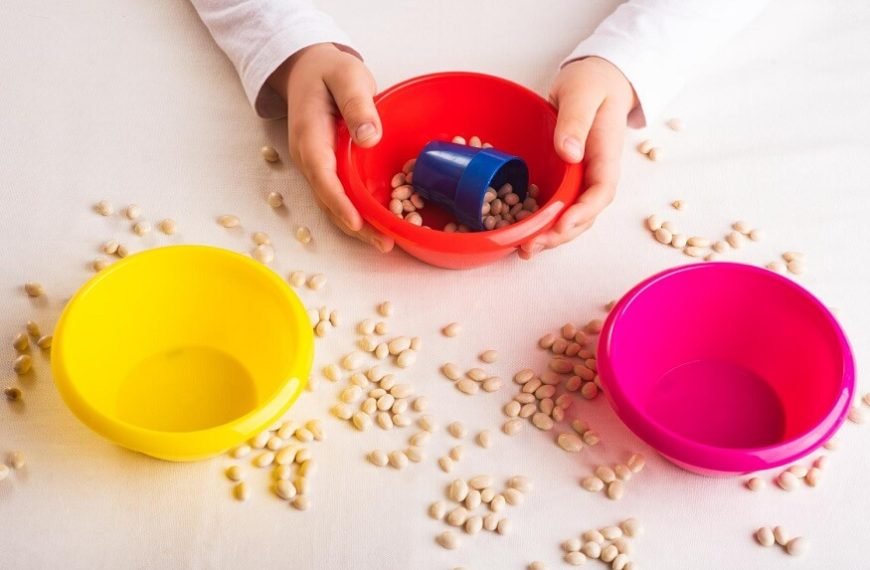Sensory play is a crucial aspect of a toddler’s development, fostering cognitive, emotional, and physical growth. One popular and effective way to introduce sensory experiences to toddlers is through sensory bins. These bins are not only entertaining but also provide numerous learning opportunities. In this exploration, we’ll delve into seven engaging sensory bins for toddlers, offering a diverse range of tactile, visual, and auditory stimuli.
Seven sensory bin ideas for toddlers:
Here, we are going to learn 7 sensory bin ideas for our toddlers.
- Rainbow Rice Bin:
- Ocean Adventure Bin:
- Nature Discovery Bin:
- Construction Zone Bin:
- Garden Exploration Bin:
- Texture Treasure Hunt Bin:
- Musical Sensation Bin:
Rainbow rice bins are a classic and vibrant sensory play option for toddlers. Create different layers of colored rice using food coloring and vinegar, allowing toddlers to explore various textures and colors. This activity enhances fine motor skills as children scoop, pour, and dig through the rice. Additionally, it introduces concepts like color recognition and sorting, making it a multi-sensory learning experience.
Bring the wonders of the ocean into your toddler’s playtime with ocean-themed sensory bins. Fill a container with blue water beads to mimic the ocean, and add sea animal toys for an immersive experience. The cool, slippery texture of the water beads provides a unique tactile sensation, while the sea creatures encourage imaginative play. This bin also serves as a fantastic opportunity to teach toddlers about marine life and different textures found in the ocean.
Connect toddlers with the natural world by creating nature-inspired sensory bins. Fill a container with items like leaves, twigs, pinecones, and acorns. Incorporate different textures, scents, and colors found in nature. This bin not only stimulates the senses but also introduces toddlers to the concept of nature through touch and smell. Encourage them to explore the various elements, fostering a love for the outdoors.
For toddlers fascinated by trucks and construction, a construction zone sensory bin is a perfect match. Fill a container with kinetic sand, small construction vehicles, and construction site props. Kinetic sand provides a moldable and sensory-rich medium, allowing toddlers to build, dig, and create their mini-construction projects. This bin promotes imaginative play, fine motor skills, and an understanding of basic construction concepts.
Introduce toddlers to the world of gardening with a garden exploration sensory bin. Fill a container with soil, small potted plants, and toddler-friendly gardening tools. This bin offers a hands-on experience with soil textures, and toddlers can practice planting and digging with miniature shovels and rakes. As they engage in pretend play, they also learn about the basics of gardening and plant care.
Create a sensory-rich treasure hunt for toddlers by assembling a bin with various textures. Include items like soft fabrics, rough sandpaper, smooth stones, and fuzzy pom-poms. Blindfold the toddlers and encourage them to explore the different textures using their hands. This activity enhances tactile sensitivity, fine motor skills, and the ability to distinguish between textures. It also adds an element of excitement as toddlers search for hidden treasures within the bin.
Stimulate auditory senses with a musical sensation bin. Fill a container with items that produce different sounds, such as bells, shakers, and drums. Include textured materials like ribbons and fabrics to enhance the tactile experience. As toddlers explore the various instruments and materials, they not only develop their sense of touch but also discover the joy of creating different sounds. This sensory bin fosters a love for music and rhythm from an early age.
Importance of sensory bins for toddlers
- Cognitive Development:
- Fine and Gross Motor Skills:
- Language Development:
- Sensory Stimulation:
- Emotional Regulation:
- Creativity and Imagination:
- Social Skills:
- Bonding and Quality Time:
Engaging bins provide a rich environment for cognitive development in toddlers. As they interact with different textures, shapes, and colors, toddlers engage their brains in processing information, fostering problem-solving skills and spatial awareness. The hands-on nature of sensory play enhances their ability to understand cause and effect, promoting cognitive growth in these formative years.
Manipulating objects within engaging bins requires toddlers to refine their fine and gross motor skills. Pouring, scooping, and grasping various materials help in developing hand-eye coordination and muscle strength. These activities contribute to the refinement of their motor skills, laying the foundation for more complex tasks as they grow.
Engaging bins also play a crucial role in language development. As toddlers explore the contents of the bins, they are exposed to new vocabulary related to textures, shapes, and sensations. Verbal communication during sensory play sessions further enhances language acquisition, as caregivers describe the various materials, encouraging toddlers to express themselves.
Sensory bins provide a multisensory experience, stimulating not only touch but also sight, hearing, and sometimes even smell. Exposure to a variety of sensory inputs helps toddlers make connections in their brains, promoting sensory integration. This, in turn, can have positive effects on their ability to focus, regulate emotions, and adapt to different environments.
Engaging bins offer a safe space for toddlers to explore and express their emotions. The tactile and soothing nature of sensory play can have a calming effect, aiding in emotional regulation. It becomes a tool for self-soothing and learning to manage different feelings, which is particularly important during this stage of emotional development.
One of the remarkable aspects of engaging bins is their ability to fuel creativity and imagination. The open-ended nature of sensory play allows toddlers to use the materials in various ways, encouraging them to invent stories, scenarios, and even simple games. This creativity lays the groundwork for later imaginative and abstract thinking.
Engaging bins can be used in group settings, fostering social interaction and cooperation among toddlers. Sharing materials, taking turns, and collaborating on a common sensory experience promote the development of essential social skills. It also provides an opportunity for caregivers to model and teach appropriate social behaviors.
Engaging in sensory play with toddlers creates opportunities for bonding between caregivers and children. Sharing these experiences builds a foundation of trust and strengthens the caregiver-child relationship. The focused, interactive nature of engaging bins also allows caregivers to be fully present, enhancing the quality of the time spent together.
At EuroKids, we understand that these Fun sensory bin ideas for toddlers are a wonderful way to promote exploration, creativity, and learning in young children. Sensory play is a powerful tool for toddler development, offering a multitude of benefits across various domains. As parents or educators, incorporating these sensory bins into a toddler’s playtime can create a rich and holistic learning environment that supports their growth and curiosity.
















